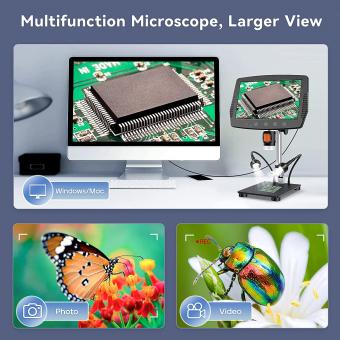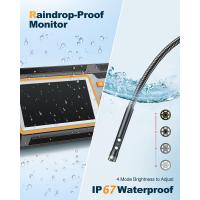Can Molecules Be Seen With A Microscope ?
Molecules cannot be seen with a traditional light microscope as they are too small. The size of a molecule is typically on the order of nanometers (10^-9 meters), while the resolution of a light microscope is limited to around 200 nanometers. However, there are specialized microscopes such as scanning tunneling microscopes and atomic force microscopes that can visualize individual atoms and molecules. These microscopes use a probe that scans the surface of a sample and detects the interactions between the probe and the atoms or molecules on the surface. This allows for the creation of high-resolution images of individual molecules.
1、 Microscopy techniques for visualizing molecules

Microscopy techniques for visualizing molecules have advanced significantly in recent years, allowing scientists to observe and manipulate individual molecules with unprecedented precision. However, the question of whether molecules can be seen with a microscope is not a straightforward one.
Traditional light microscopes are limited by the diffraction limit, which means that they cannot resolve objects smaller than approximately half the wavelength of the light used to illuminate them. Since molecules are typically much smaller than this limit, they cannot be directly observed with a traditional light microscope.
However, there are several advanced microscopy techniques that can be used to visualize molecules. For example, electron microscopy can be used to observe the structure of individual molecules at high resolution. Scanning probe microscopy, such as atomic force microscopy, can also be used to visualize individual molecules by scanning a tiny probe over their surface.
In recent years, super-resolution microscopy techniques have also been developed, which allow scientists to overcome the diffraction limit and observe individual molecules with unprecedented detail. These techniques include stimulated emission depletion microscopy (STED), structured illumination microscopy (SIM), and single-molecule localization microscopy (SMLM).
In summary, while traditional light microscopes cannot directly observe individual molecules, advanced microscopy techniques have made it possible to visualize and manipulate molecules with increasing precision. The latest point of view is that the development of new microscopy techniques will continue to push the boundaries of what is possible in molecular visualization and manipulation.
2、 Limitations of traditional light microscopy

Limitations of traditional light microscopy:
Traditional light microscopy has been a valuable tool for scientists to study the structure and function of cells and tissues. However, there are limitations to what can be seen with a traditional light microscope. One of the main limitations is the resolution, which is the ability to distinguish two closely spaced objects as separate entities. The resolution of a light microscope is limited by the wavelength of light, which is around 500 nanometers. This means that structures smaller than this cannot be seen with a traditional light microscope.
Can molecules be seen with a microscope?
Molecules are much smaller than the resolution limit of a traditional light microscope, so they cannot be seen directly with this type of microscope. However, there are other types of microscopes that can be used to visualize molecules. For example, electron microscopy uses a beam of electrons instead of light to create an image, which allows for much higher resolution. This type of microscopy can be used to visualize individual molecules and even atoms.
Latest point of view:
In recent years, there have been significant advances in microscopy technology, including the development of super-resolution microscopy techniques. These techniques use fluorescent molecules that can be switched on and off, allowing for the precise localization of molecules within cells. This has revolutionized the field of cell biology, allowing scientists to study the organization and dynamics of molecules within cells at a much higher resolution than was previously possible.
In conclusion, while traditional light microscopy has limitations in terms of what can be seen, there are other types of microscopes that can be used to visualize molecules. Additionally, advances in microscopy technology have led to the development of super-resolution techniques, which have greatly expanded our ability to study the structure and function of cells and molecules.
3、 Advances in electron microscopy for molecular imaging

Advances in electron microscopy for molecular imaging have revolutionized our ability to visualize and study molecules. With the development of cryo-electron microscopy (cryo-EM), it is now possible to obtain high-resolution images of individual molecules and even large molecular complexes. This technique involves freezing samples in vitreous ice, which preserves their native state and allows for imaging without the need for staining or fixation.
While traditional light microscopes are limited by the diffraction limit, which prevents the visualization of objects smaller than the wavelength of light, electron microscopes use beams of electrons to achieve much higher resolution. This allows for the visualization of individual atoms and molecules, which are too small to be seen with traditional microscopes.
However, it is important to note that even with cryo-EM, molecules cannot be seen directly. Instead, the technique relies on the scattering of electrons by the sample, which produces a 2D projection image. These images are then combined to create a 3D reconstruction of the molecule or complex.
The latest advances in cryo-EM have allowed for even higher resolution imaging, with structures being resolved at near-atomic resolution. Additionally, new techniques such as single-particle cryo-EM and focused ion beam milling have expanded the range of samples that can be imaged, including membrane proteins and large macromolecular complexes.
In summary, while molecules cannot be seen directly with a microscope, advances in electron microscopy have allowed for the visualization of individual molecules and large molecular complexes at high resolution. These techniques continue to evolve and improve, providing new insights into the structure and function of biological molecules.
4、 Scanning probe microscopy for high-resolution imaging

Scanning probe microscopy (SPM) is a powerful tool for high-resolution imaging of molecules and other nanoscale structures. SPM techniques, such as atomic force microscopy (AFM) and scanning tunneling microscopy (STM), allow researchers to visualize individual atoms and molecules with unprecedented detail.
However, it is important to note that SPM techniques do not directly "see" molecules in the traditional sense. Instead, they rely on the interaction between a sharp probe and the surface of a sample to create a topographic map of the surface. By scanning the probe across the surface and measuring the forces between the probe and the sample, SPM techniques can create images with sub-nanometer resolution.
Recent advances in SPM technology have enabled researchers to study a wide range of materials and systems, from biological molecules to semiconductor devices. For example, AFM has been used to study the structure and function of proteins, while STM has been used to investigate the electronic properties of graphene and other two-dimensional materials.
Overall, while SPM techniques do not directly "see" molecules, they provide a powerful tool for high-resolution imaging and characterization of nanoscale structures. As SPM technology continues to advance, it is likely that we will gain even deeper insights into the behavior of molecules and other nanoscale systems.





































